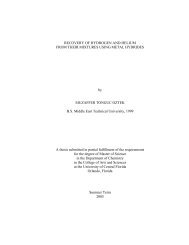You also want an ePaper? Increase the reach of your titles
YUMPU automatically turns print PDFs into web optimized ePapers that Google loves.
hydrogen capacity was not reproducible due to commercial unavailability of<br />
manufacturing equipment supplies.<br />
Zirconium based alloy ZrCo was reported to absorb less than 0.1% hydrogen at<br />
473 K [31]. ZrNi was reported to absorb approximately 3% hydrogen at room<br />
temperature, with a considerable hysteresis during desorption, and the reaction between<br />
ZrNi and H 2 was completed in more than 55 hours [32]. Zr 3 Al 2 , ZrV 2 and ZrNi particle<br />
beds were reported to rapidly and selectively remove hydrogen from a hydrogen/argon<br />
stream, eventually reducing the hydrogen content from 10% to 1 ppm by low temperature<br />
H 2 adsorption [19].<br />
1.3. LaNi 5<br />
After a review of several the candidate materials, Mg 2 Ni, VTiNi and LaNi 5 were<br />
selected for study. Emphasis was placed on LaNi 5 , as will be discussed in this thesis. It<br />
was selected because it exhibits excellent properties for use in a successful hydrogen<br />
recovery-storage-delivery system [2]. LaNi 5 rapidly reaches equilibrium with hydrogen,<br />
even at low pressures and temperatures. Also, the hydriding and dehydriding processes<br />
are reversible at H 2 partial pressures close to atmospheric [28]. LaNi 5 exhibits low<br />
hysteresis and is not strongly affected by gaseous impurities or by oxidation. On<br />
compounds such as Nb, V, Ta, FeTi, oxidation creates a barrier for the interaction and<br />
dissociation of H 2 molecules. On the surface of LaNi 5 , the highly reactive La reacts with<br />
11



